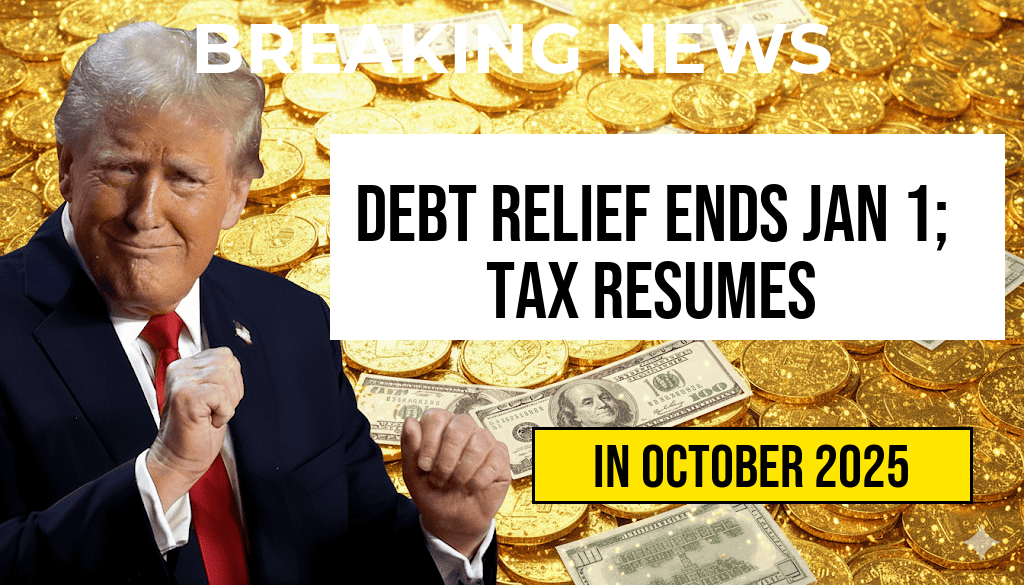Student Debt Relief Ends January 1, Resumption of Tax on Forgiven Balances Eliminates $20,000 Relief
After a temporary pause, the federal government’s policy of forgiving student loan debt under the recent relief program is set to expire on January 1. As a result, borrowers who have received loan forgiveness will face the reimposition of taxes on the forgiven amounts, effectively erasing the previously offered $20,000 relief for many. The decision marks a significant shift for millions of borrowers who had relied on the program to ease their financial burdens, and it signals a return to standard tax practices that could impact household finances nationwide.
The student debt forgiveness initiative, which allowed eligible borrowers to have part or all of their federal student loans discharged without immediate repayment, was introduced as a temporary measure amid economic recovery efforts. However, the Internal Revenue Service (IRS) clarified that forgiven student loan amounts will now be considered taxable income starting January 1, 2024, unless new legislation is enacted. This means that borrowers who received debt cancellation since the program’s inception will likely face a tax bill based on the amount forgiven, often amounting to thousands of dollars per individual.
Background: The Student Debt Relief Program and Its Impacts
The student debt forgiveness program was launched as a response to rising concerns over the burden of student loans, which have increased dramatically over the past decade. Initially, it aimed to provide relief to borrowers struggling under the weight of high debt levels and to stimulate economic activity by reducing monthly repayment obligations. The program temporarily suspended loan payments during the COVID-19 pandemic, providing additional financial breathing room for millions.
In 2021, the Biden administration announced targeted debt cancellation plans, offering up to $10,000 in forgiveness for certain borrowers, with some proposals extending relief up to $20,000. While these initiatives faced legal challenges and legislative pushback, they temporarily kept the promise of debt relief alive. The recent decision to end the program on January 1, 2024, stems from legislative and administrative considerations, including concerns over budget impacts and political debates surrounding debt forgiveness.
Tax Implications: Forgiven Student Debt as Taxable Income
How the Resumption of Taxation Will Affect Borrowers
Under current IRS guidelines, any amount of student loan debt forgiven after January 1, 2024, will be treated as taxable income. This means that borrowers who had their loans discharged during the relief period might now face a substantial tax bill. For example, a borrower who received $20,000 in forgiveness could see a tax liability of approximately $3,000 to $5,000, depending on their income tax bracket.
| Forgiven Amount | Estimated Tax Liability (at 22% tax rate) | Net Relief After Tax |
|---|---|---|
| $10,000 | $2,200 | $7,800 |
| $20,000 | $4,400 | $15,600 |
| $30,000 | $6,600 | $23,400 |
Legislative Efforts and Potential Relief
There have been calls from Congress and advocacy groups to modify the tax treatment of forgiven student debt. Some lawmakers are pushing for legislation that would exempt forgiven amounts from taxation, similar to provisions for mortgage debt cancellation or certain disaster relief programs. However, as of now, no such measures have been passed, leaving borrowers to face the tax consequences unless new legislation intervenes.
Impacts on Borrowers and Broader Economic Considerations
The end of the student debt relief program and the reimposition of taxes on forgiven balances could have widespread effects. Borrowers who expected to benefit from the debt cancellation may now need to prepare for larger tax bills, which could strain household budgets, especially for those already facing financial challenges. According to recent estimates, approximately 30 million Americans received at least some student loan forgiveness during the relief period, with many likely unaware of potential tax implications.
Financial advisors recommend that borrowers review their situations carefully and consult with tax professionals to understand their liabilities. The abrupt policy shift also raises questions about the future of student debt policy in the U.S., as legislative debates continue over how best to address the ongoing student debt crisis.
Resources and Next Steps
Borrowers seeking detailed guidance can consult the IRS’s official resources on income taxation and student loan forgiveness at irs.gov. Additionally, the Department of Education continues to provide updates on repayment options and potential legislative changes on its website.
As the new year approaches, those affected are advised to review their loan records, explore repayment plans, and consider consulting financial professionals to mitigate unforeseen tax consequences stemming from the expiration of the student debt relief program.
Frequently Asked Questions
What is ending on January 1 regarding student debt amnesty?
The student debt amnesty program is ending on January 1, which means that the tax relief associated with forgiven student loans will also cease.
How does the end of student debt amnesty affect forgiven balances?
Once the amnesty ends, forgiven student loan balances will be considered taxable income, resulting in a tax obligation on the amount forgiven.
What is the impact of the $20,000 relief elimination?
The $20,000 relief that previously provided tax exemptions for forgiven student debt will be eliminated, potentially increasing the financial burden on borrowers.
Who will be affected by the ending of student debt amnesty and tax on forgiven balances?
Borrowers with outstanding student loans who receive forgiveness after January 1 will be impacted, as they will face tax liabilities on the forgiven amounts.
Are there any options or alternatives for borrowers concerned about the tax on forgiven student debt?
Borrowers should consider consulting with a financial advisor or exploring loan repayment plans and forgiveness programs to better understand how to manage potential tax liabilities after the amnesty ends.

Leave a Reply